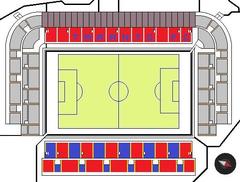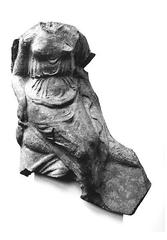
Castello Aragonese Taranto: Complete Visiting Hours, Tickets, and Historical Sites Guide
Date: 04/07/2025
Introduction
Rising at the strategic junction between the Ionian and Adriatic Seas, the Castello Aragonese of Taranto stands as a majestic symbol of the city’s millennia-old maritime and military heritage. With origins dating back to ancient Greek and Byzantine times, and shaped over centuries by Norman, Swabian, Angevin, and Aragonese rule, the castle today is a meticulously preserved monument managed by the Italian Navy. Its robust Renaissance architecture, innovative defensive features, and archaeological layers narrate a compelling story of adaptation and resilience. As both a cultural hub and a living historical site, Castello Aragonese is a must-visit for anyone exploring southern Italy.
To plan your visit—including up-to-date information on opening hours, ticketing, accessibility, and nearby attractions—consult the official Castello Aragonese Taranto website and the Taranto Capitale di Mare portal. For additional context, Italia.it offers a broader look at Taranto’s historical significance and travel planning resources.
Contents
- Historical Overview and Architectural Evolution
- Architectural Features and Archaeological Discoveries
- Visiting Information: Hours, Tickets, Accessibility
- Visitor Experience and Nearby Attractions
- Practical Visitor Tips
- Frequently Asked Questions (FAQ)
- Visuals and Media Recommendations
- References and Further Reading
Historical Overview and Architectural Evolution
Early Foundations and Strategic Importance
The site of Castello Aragonese has served as a defensive stronghold since at least the Greek era (4th–3rd centuries BC), owing to its crucial position at the entrance of Taranto’s harbor. Successive rulers—including Byzantines, Normans, Swabians, and Angevins—expanded and adapted the fortifications to meet evolving military needs (Ecosistema Taranto).
Aragonese Construction and Military Innovation
In the late 15th century, King Ferdinand II of Aragon commissioned Francesco di Giorgio Martini to redesign the castle. The resulting fortress featured low, thick limestone walls, rounded towers, and a moat system, all intended to withstand the era’s advanced artillery (Wikipedia). Strategic adaptation included creating a navigable canal that effectively isolated the castle from the mainland, enhancing its defensive potential.
Later Modifications and Changing Roles
During the Spanish and Bourbon periods, the castle’s structure was modified to accommodate new military technologies. Later, it served as a royal residence and, under Habsburg rule, as a prison. The Italian Navy assumed stewardship in 1883, transforming the castle into a cultural and educational hub, while major restorations beginning in 2003 reopened significant historic spaces (Ecosistema Taranto).
Architectural Features and Archaeological Discoveries
Key Architectural Elements
- Towers and Bastions: Four surviving circular towers (St. Cristoforo, St. Lorenzo, dell’Annunziata, and della Bandiera) exemplify Renaissance military innovation, offering panoramic harbor views and overlapping defensive fields (Taranto Capitale di Mare).
- Curtain Walls and Moat: Massive limestone walls and the integrated canal/moat system underscore the castle’s strategic design (Wikipedia).
- Interiors: Visitors can explore vaulted halls, underground passages, and the Renaissance Chapel of San Leonardo, which has served various functions over centuries (ImaginApulia).
Archaeological Discoveries
Extensive excavations have unveiled layers from Greek, Byzantine, Medieval, and Aragonese periods. Key finds include:
- Greek pottery and defensive walls.
- Byzantine brickwork and religious objects.
- Medieval towers and domestic artifacts.
- Aragonese cannonballs and gunports.
Restoration efforts—often in partnership with the University of Bari—have revealed original stonework, frescoes, and long-sealed corridors, many now accessible to the public (Ecosistema Taranto).
Visiting Information: Hours, Tickets, Accessibility
Visiting Hours
- Standard Hours: Tuesday to Sunday, 9:00 AM to 7:00 PM (last admission one hour before closing). Closed Mondays and public holidays.
- Guided Tours: Conducted exclusively by Italian Navy personnel. Schedules may vary seasonally; always verify via the official website.
Tickets and Admission
- Admission: Free. No tickets are required for individual visitors (official website).
- Group Visits: Advance booking recommended (+39 099 7753438).
- Reservations: Not required for individuals; first-come, first-served basis.
Accessibility
- Physical Access: Ground-level areas are wheelchair accessible; upper sections and underground passages may be challenging due to stairs and uneven surfaces.
- Facilities: On-site restrooms; photography is permitted (restrictions may apply); pets allowed if leashed and, for larger dogs, muzzled (official website).
Health & Safety
- Tours may be canceled or modified due to adverse weather. Check for updates before visiting.
Visitor Experience and Nearby Attractions
Tour Highlights
- Guided Experience: All tours are led by Italian Navy guides, offering in-depth historical and architectural context.
- Naval Exhibition: The castle features a permanent collection of ship models by Erminio Fazzioli.
- Chapel of San Leonardo and Prison Cells: Key stops on the tour, illustrating the building’s multifaceted history.
Best Times to Visit
- Spring (April–May) and Autumn (September–October): Mild weather, fewer crowds (Savoring Italy).
- Summer: Early morning or evening tours recommended due to high temperatures.
Nearby Attractions
- Città Vecchia (Old Town): Medieval streets, artisan shops, and the Cathedral of San Cataldo.
- Doric Temple (Colonne Doriche): Ancient Greek ruins in Piazza Castello.
- Ponte Girevole (Swing Bridge): 19th-century engineering marvel, adjacent to the castle.
- National Archaeological Museum (MARTA): Renowned Magna Graecia artifact collection.
- Lungomare Vittorio Emanuele III: Scenic promenade with panoramic views.
- Piazza Fontana: Bustling square with cafes and shops (DIY Cruise Ports).
Practical Visitor Tips
- Parking: Parcheggio Piazza Archita (5–10 minutes’ walk).
- Footwear: Comfortable shoes recommended for uneven surfaces.
- Language: Tours are primarily in Italian; English explanations may be requested.
- Dining: Sample local cuisine at trattorias nearby, known for seafood and Puglian specialties.
- Day Trips: Consider excursions to Matera, Lecce, or Ostuni for further cultural exploration (Puglialy).
Frequently Asked Questions (FAQ)
Q: Are tickets required?
A: No, entry is free and no tickets are needed.
Q: What are the visiting hours?
A: Tuesday to Sunday, 9:00 AM–7:00 PM; check official website for seasonal updates.
Q: Is the castle accessible?
A: Ground floors are accessible; upper and underground areas may be difficult for those with mobility issues.
Q: Are guided tours available?
A: Yes, all visits are guided by Navy personnel.
Q: Can I bring my pet?
A: Yes, with a leash and muzzle for larger dogs.
Q: Where can I park?
A: Parcheggio Piazza Archita is recommended.
Visuals and Media Recommendations
Explore high-resolution images and virtual tours on the official website. Look for visuals of the main gate, towers, panoramic sea views, and naval model displays. Use alt tags such as “Castello Aragonese Taranto visiting hours” for accessibility and search optimization.
References and Further Reading
- Ecosistema Taranto, Castello Aragonese Archaeological Discoveries
- Wikipedia, Castello Aragonese (Taranto)
- Taranto Capitale di Mare, The Aragonese Castle
- Italia.it, Aragonese Castle of Taranto
- ImaginApulia, Aragonese Taranto Castle
- DIY Cruise Ports, Taranto Cruise Port Guide
- TripHobo, Castello Aragonese Taranto
- Savoring Italy, Taranto Italy Travel Guide
- Puglialy, Day Trip Taranto
- Official Taranto Tourism, Castello Aragonese Tickets
- Official Castello Aragonese Taranto Website, Visiting Hours and Info
Final Thoughts
Castello Aragonese is much more than a fortress—it is a living chronicle of Taranto’s evolution and a vital part of Italy’s Mediterranean heritage. Free guided tours, layered architectural wonders, and its proximity to other historical treasures make it an essential stop in any Apulian itinerary. Enhance your visit by downloading the Audiala app for digital guides and insider tips, and always consult the official website for the most current information.









